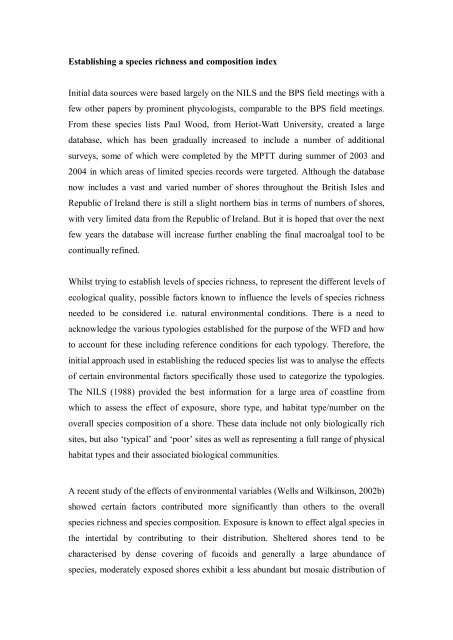Water Framework Directive Marine Plants Task Team Tools Paper ...
Water Framework Directive Marine Plants Task Team Tools Paper ...
Water Framework Directive Marine Plants Task Team Tools Paper ...
Create successful ePaper yourself
Turn your PDF publications into a flip-book with our unique Google optimized e-Paper software.
Establishing a species richness and composition index<br />
Initial data sources were based largely on the NILS and the BPS field meetings with a<br />
few other papers by prominent phycologists, comparable to the BPS field meetings.<br />
From these species lists Paul Wood, from HeriotWatt University, created a large<br />
database, which has been gradually increased to include a number of additional<br />
surveys, some of which were completed by the MPTT during summer of 2003 and<br />
2004 in which areas of limited species records were targeted. Although the database<br />
now includes a vast and varied number of shores throughout the British Isles and<br />
Republic of Ireland there is still a slight northern bias in terms of numbers of shores,<br />
with very limited data from the Republic of Ireland. But it is hoped that over the next<br />
few years the database will increase further enabling the final macroalgal tool to be<br />
continually refined.<br />
Whilst trying to establish levels of species richness, to represent the different levels of<br />
ecological quality, possible factors known to influence the levels of species richness<br />
needed to be considered i.e. natural environmental conditions. There is a need to<br />
acknowledge the various typologies established for the purpose of the WFD and how<br />
to account for these including reference conditions for each typology. Therefore, the<br />
initial approach used in establishing the reduced species list was to analyse the effects<br />
of certain environmental factors specifically those used to categorize the typologies.<br />
The NILS (1988) provided the best information for a large area of coastline from<br />
which to assess the effect of exposure, shore type, and habitat type/number on the<br />
overall species composition of a shore. These data include not only biologically rich<br />
sites, but also ‘typical’ and ‘poor’ sites as well as representing a full range of physical<br />
habitat types and their associated biological communities.<br />
A recent study of the effects of environmental variables (Wells and Wilkinson, 2002b)<br />
showed certain factors contributed more significantly than others to the overall<br />
species richness and species composition. Exposure is known to effect algal species in<br />
the intertidal by contributing to their distribution. Sheltered shores tend to be<br />
characterised by dense covering of fucoids and generally a large abundance of<br />
species, moderately exposed shores exhibit a less abundant but mosaic distribution of

















